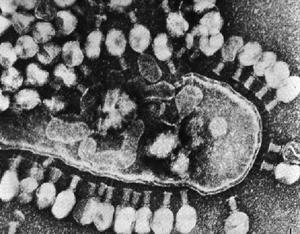Particles or microbes too small to be seen with an ordinary microscope, viruses range in size from that of a large molecule to about half the size of a small bacterium (from 0.00001 millimeter to 0.0005 millimeter). They can be photographed, however, under an electron microscope which has a magnetic field for a lens and a stream of electrons instead of a beam of light.
The growth of a virus
Viruses can only grow or reproduce inside the cells of animals, plants or bacteria. Thus they differ even from bacteria for while the latter can be cultured on plates of nutrient jellies in laboratories; the culture of viruses must be carried out in portions of living tissue artificially kept alive.
On its own, a virus is lifeless, but when it attaches to an appropriate organism it becomes totally parasitic and exploits the chemical energy and materials of the cells. In this way it grows and reproduces, forming more viruses to invade other cells.
Viruses are composed largely of nucleic acids, which are the substances that control the synthesis of living matter, and they are usually named after the diseases they cause, virus diseases range from poliomyelitis, caused by a very small virus, to smallpox, caused by a relatively large one. The common cold, influenza, measles, rubella, mumps, chicken pox, herpes and gastrointestinal upsets are other viral complaints. Further examples are psittacosis in parrots (transmissible to man), swine fever in pigs and myxomatosis in rabbits.
Viruses cause warts and possibly one form of cancer, namely Burkett’s lymphoma or sarcoma, a malignant tumour in the jaws of African children.
The identification of viruses in the laboratory is not so easy as it is with bacteria because they can be grown only in living tissue. Some viruses, for instance the smallpox virus, are identified by their mode of growth in fertile eggs. More commonly, viruses are identified by their reaction to antibodies formed in subjects who have had the viral disease. Some viruses change their character in the course of time and consequently there is a change in the nature of the disease.
Some viruses (myxoviruses), including those of influenza, have an affinity with mucus. The arbo (arthropod-borne) viruses cause yellow fever and dengue (both carried by mosquitoes), sandfly fever and tick fever. Many vague fevers are caused by viruses. Sore throat and respiratory disease, especially in infancy, are often viral.
Control and treatment of viruses
Viral infections, unlike bacterial infections, do not respond to antibiotics. After certain viral diseases the body has immunity from a further attack. Although no lasting immunity follows the common cold, artificial immunization against many viral diseases can be effective. Smallpox has been eradicated by vaccination and poliomyelitis too has become rare.
Temporary immunity to such viral diseases as infectious hepatitis can be obtained by means of an injection of gamma globulin. This is useful for those who have been in contact with the disease.
In the treatment of viral disease, antibiotics are not effective. There are, however, two antiviral drugs, idoxuridine and vidarabine. Idoxuribine is useful for herpes infection of the eye and lips and sometimes for shingles (herpes zoster). Vidarabine, useful for herpes of the eye, is also effective when given by vein for the rare herpes simplex encephalitis.
Source:
CURRENT BIOLOGY
Volume 16, Issue 19
Pages: 163-166
Published: December 2007






